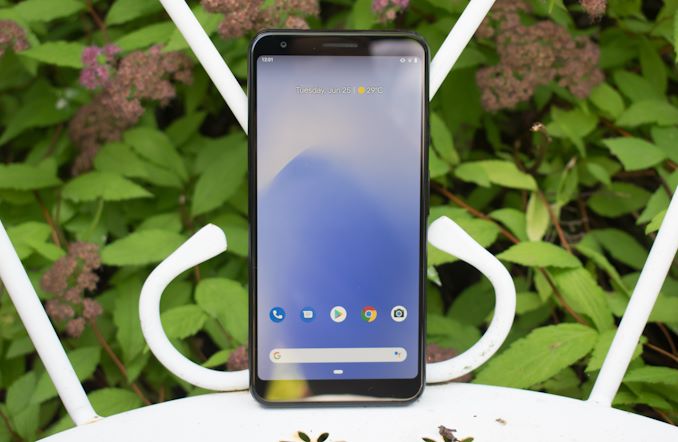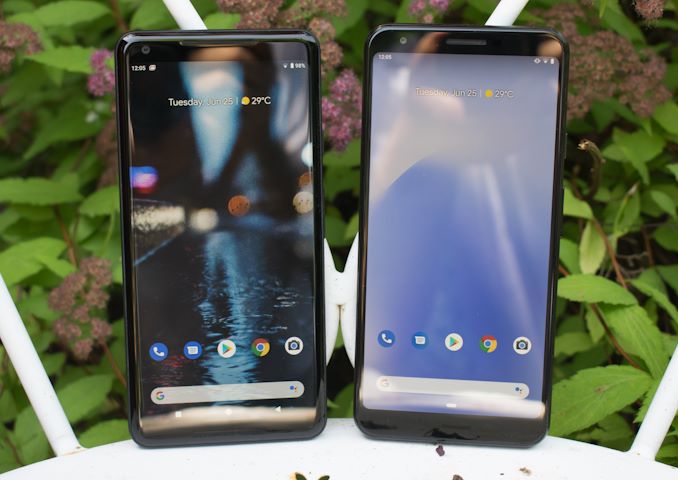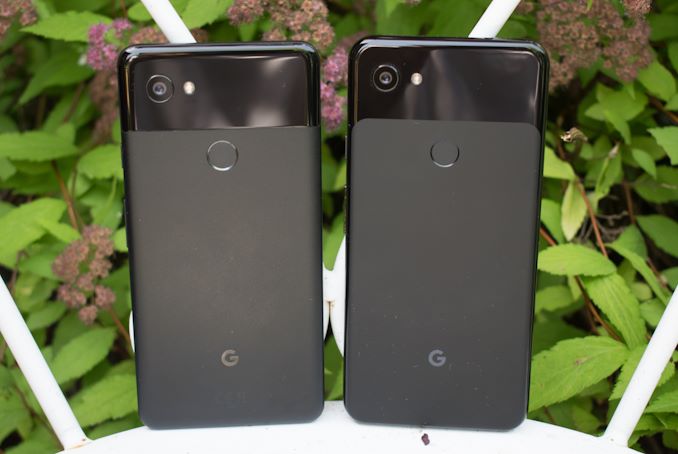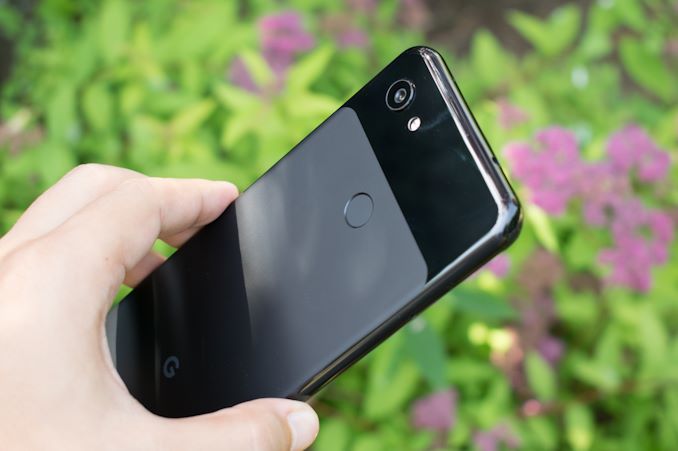The Google Pixel 3a XL Review: Does Mid-Range Make Sense?
by Andrei Frumusanu on June 27, 2019 8:00 AM EST- Posted in
- Mobile
- Smartphones
- Snapdragon 670
- Pixel 3a
- Pixel 3a XL

It’s nearing 8 months since Google released the Pixel 3 and we extensively reviewed the phone. It also has been several years now since Google abandoned the Nexus line of devices; one of the most attractive aspects during the early days of Google’s own phones was their incredible value proposition and very competitive pricing. As Google evolved the Pixel line of smartphones, it was clear that we’d no longer see quite as attractive price-tags, with the Pixel 3 and Pixel 3 XL nearing the $1000/€ mark.
Google apparently did see the higher price points as a hurdle for some consumers, and decided to expand its product line-up by introducing new mid-range devices at much more reasonable price-points, all while maintaining the key features that make the Pixel phones worth their namesake.
The new Pixel 3a and Pixel 3a XL, the latter which we’re reviewing today, are very much derived from the same DNA that was established in the Pixel 2 and further iterated upon in the Pixel 3 range. The Pixel 3a’s still come with the similar industrial design, feature an OLED display, and most importantly feature the very same full-fledged camera as their flagship siblings, at essentially half the cost. Of course, the lower price point comes with changes – a plastic body and a lower tiered SoC are among some of the compromises that have been made, along with a few other features that hit the chopping block.
| Google Pixel 3a's | ||||
| Pixel 3a |
Pixel 3a XL (Reviewed) |
|||
| SoC | Snapdragon 670 2x Kryo 360 (CA75) @ 2.0GHz 6x Kryo 360 (CA55) @ 1.7GHz Adreno 615 |
|||
| DRAM | 4GB LPDDR4X | |||
| Display | 5.6" OLED 2220 x 1080 (18:9) |
6.0" OLED 2220 x 1080 (18:9) |
||
| Size | Height | 151.3 mm | 160.1 mm | |
| Width | 70.1 mm | 76.1 mm | ||
| Depth | 8.2 mm | 8.2 mm | ||
| Weight | 147 grams | 167 grams | ||
| Battery Capacity | 3000mAh (Rated) | 3700mAh (Rated) | ||
| Wireless Charging | - | |||
| Rear Cameras | ||||
| Main | 12.2MP 1.4µm Dual Pixel PDAF f/1.8 76° lens with OIS |
|||
| Telephoto | - | |||
| Wide | - | |||
| Extra | - | |||
| Front Camera | 8MP 1.12µm f/2.2 84° lens; fixed focus |
|||
| Storage | 64GB eMMC | |||
| I/O | USB-C 3.5mm headphone jack |
|||
| Wireless (local) | 802.11ac Wave 2 Wi-Fi Bluetooth 5.0 LE + NFC |
|||
| Cellular | UE Category 11 (DL) / Category 5 (UL) 600Mbit/s DL (3xCA 2x2 MIMO) 75Mbit/s UL |
|||
| Other Features | Dual Speakers, 18W Fast Charging | |||
| Dual-SIM | 1x nanoSIM | |||
| Launch Price | $399 / £399 / €399 | $479 / £469 / €479 | ||
Starting off with the internal hardware of the Pixel 3a’s, we see the devices powered by a Qualcomm Snapdragon 670 SoC. Qualcomm had launched the SoC in August of 2018, so it’s not quite the newest unit on the market, but given the price sensitivity of the product category, that’s to be expected.
The Snapdragon 670 on paper looks very similar to the slightly higher-end Snapdragon 710: The SoC features 2x Cortex A75 derived cores at 2.0GHz and are paired with 6x Cortex A55 derived cores at 1.7GHz. In terms of computational power, it’s clear that we should be expecting the CPUs to perform quite a lot less than the Snapdragon 855 as well as last year’s Snapdragon 845. In terms of single-threaded performance at least, however theoretically the S670 would be able to compete with the S835, which was Qualcomm’s flagship for 2017. In fact, we’ll see some large performance similarities between the Pixel 3a and the Pixel 2, which is going to play a big part in terms of properly evaluating the end value of the Pixel 3a.
The GPU is an Adreno 615. Unfortunately we don’t tend to review mid-range SoC phones as much as we’d like to, so at first glance without testing there’s not too much context on exactly where this GPU lands in terms of performance. While I don’t want to spoil too much, don’t expect too much performance from the smaller IP block, although we’ll see some surprising power characteristics.
The phone comes with 4GB of LPDDR4X sourced by Micron – which is standard for the course and in my opinion still sufficient for today’s workloads – although it’s now on the lower threshold of what phones should be equipped with.
Arguably the phone’s biggest component compromise comes in the form of eMMC storage of which the devices only come with 64GB of, also made by Micron. While the typical NAND speed benchmarks aren’t too terrible, the different storage standard does struggle under heavy parallel workloads.
The display on the Pixel 3a XL is an OLED panel with a diameter of 6.0” with a resolution of 2220 x 1080 and a resulting aspect ratio of 18:9. The phone’s width is very similar to the Pixel 2 XL and Pixel 3 XL, so it’s still very much a big phone.
While the back of the phone very much looks nearly identical to the Pixel 2 XL or Pixel 3 XL, there’s one very major difference: Instead of being a metal or glass back body, the Pixel 3a’s come with a full plastic unibody shell.
The design decision very likely saves a lot on the production cost of the phone, and in my opinion Google’s material choice on the 3a’s has been excellent. The polycarbonate used is of very high quality and definitely one of the best plastic phones I’ve encountered. The phone still features the characteristic glossy top part of the phone, while the bottom is a sanded off matte finish that is surprisingly close to the finish of the glass back on the regular Pixel 3’s, which is great.
The one biggest issue I feel is that the plastic design will be significantly more prone to scratches and dents, and I especially don’t expect the top glossy part of the phone to remain unblemished after a few months of use.
A big selling point for the Pixel 3a is that it sports the very same camera module as the flagship Pixel 3 units. We find the Sony IMX363 sensor which is a 12.2MP unit consisting of 1.4µm pixels with full-sensor dual-pixel PDAF ability. The module houses the same OIS and f/1.8 aperture lens.
On the front camera, Google has dropped the wide-angle module from the Pixel 3 and the 3a only houses the regular front-facing camera, which is an 8MP 1.12µm pixel f/2.2 lens with fixed focus.
It’s to be noted that while Google has dropped the 3.5mm headphone jack from the Pixel 2 and 3, it does make a comeback for the Pixel 3a. Google explains that this is meant to make the device accessible to more users. It’s a bit sad that nowadays you have to buy a lower-tier smartphone to regain a lost feature.
Among other dropped features on the Pixel 3a is the lack of wireless charging. The 3700mAh unit on the XL and 3000mAh should fare fairly fine, and it is an acceptable compromise given the device’s price ranges of $399 for the 3a and $479 for the 3a XL.














94 Comments
View All Comments
Threska - Sunday, June 30, 2019 - link
"Besides, it wears off on devices that are constantly being fondled by their owners."Alright everybody, stop "fondling" your phones. People are starting to talk. :-D
PeachNCream - Thursday, June 27, 2019 - link
The lack of microSD is a huge pain in the arse for people that use their phones as primary compute devices. That's been a brain dead move on Google's part for a long time now so it isn't a surprise. Also, mid-range and $400-500? Someone is on some good drugs if they're positioning a device with that kind of price in the middle as it falls in on the lower end of insanity, a fair bit above high priced.UtilityMax - Thursday, August 1, 2019 - link
So your phone is the primary storage for all your data, documents, music, tax returns, games, etc? Interesting choice..sing_electric - Thursday, June 27, 2019 - link
Even in North America, the value proposition of the Pixels kind of falls apart when you look at actual "street" pricing - Samsung's and LG phones often go on sale for significantly less than their MSRP (even at or near launch), and carriers (and the OEM) tend to fofer more generous trade-ins than Google seems to be willing to do.I've seen the S10e - S855, more RAM and more (and faster) storage, wireless charging, multiple cameras - go on sale for $500, just $20 more than the 3a XL, and its screen size slots it directly between the smaller and larger Pixels.
Not that any of it matters, though, because Google's done such a terrible job marketing the Pixel line that I don't think they'd be a sales hit no matter what...
melgross - Thursday, June 27, 2019 - link
Almost nobody buys Pixel labeled products, just as they didn’t buy Nexus labeled products before them,I understand that Google is trying to, at least partly, move away from being an advertising company, needing more user data in order to survive. But their hardware is a waste of time. It’s never going anywhere, just like Microsoft’s hardware, other than the XBox, which they’re still losing money on.
Speedfriend - Friday, June 28, 2019 - link
"Almost nobody buys Pixel labeled products" that is why they were the third best selling phone type in the US and 5th best in western Europe in Q4 2018MadManMark - Monday, July 1, 2019 - link
All you just did here was demonstrate to knoweldgable readers that we should ignore all the other posts you made to this thread because you simply don't know what you are talking about.darkswordsman17 - Thursday, June 27, 2019 - link
Er, that's a weird argument considering the sales that happened immediately on the Pixel3A. Especially for older Pixel owners (1 or 2) where they were effectively getting it for free after trading in their older Pixel. There's sales on all sorts of phones, so unless its an official MSRP change, then reviewers need to based their value propositions on that. Many people do not quality for some of those sales as it requires new activation or adding a line and good enough credit (or the ability to pay MSRP+tax and then get it back via bill credits). Or various other loops you have to jump through.What other marketing do you want them to do? I watch as little content that includes commercials as possible but I saw as many Pixel ads as I saw iPhone ads when I did. Not only that, but its not like they need the marketing, anytime they bring out a new phone the entire tech media discusses it just like they do iPhones and Samsung's phones. They don't sell like either of those, but I don't think that was ever Google's actual intent with the Pixel stuff.
UtilityMax - Thursday, August 1, 2019 - link
All the "cheap" new phones require activation of new line, or contract, or some kind of monthly payment plan. Moreover, the carrier branded LG phones are probably the worst garbage I have seen among android phones.3DoubleD - Thursday, June 27, 2019 - link
The article says the Pixel 3a XL compares well to the S835, but the charts show it comparing well to the S845, which is found in the Samsung Galaxy S9+. In fact, the S8/S8+ that would have the S835 SoC isn't even in the chart.